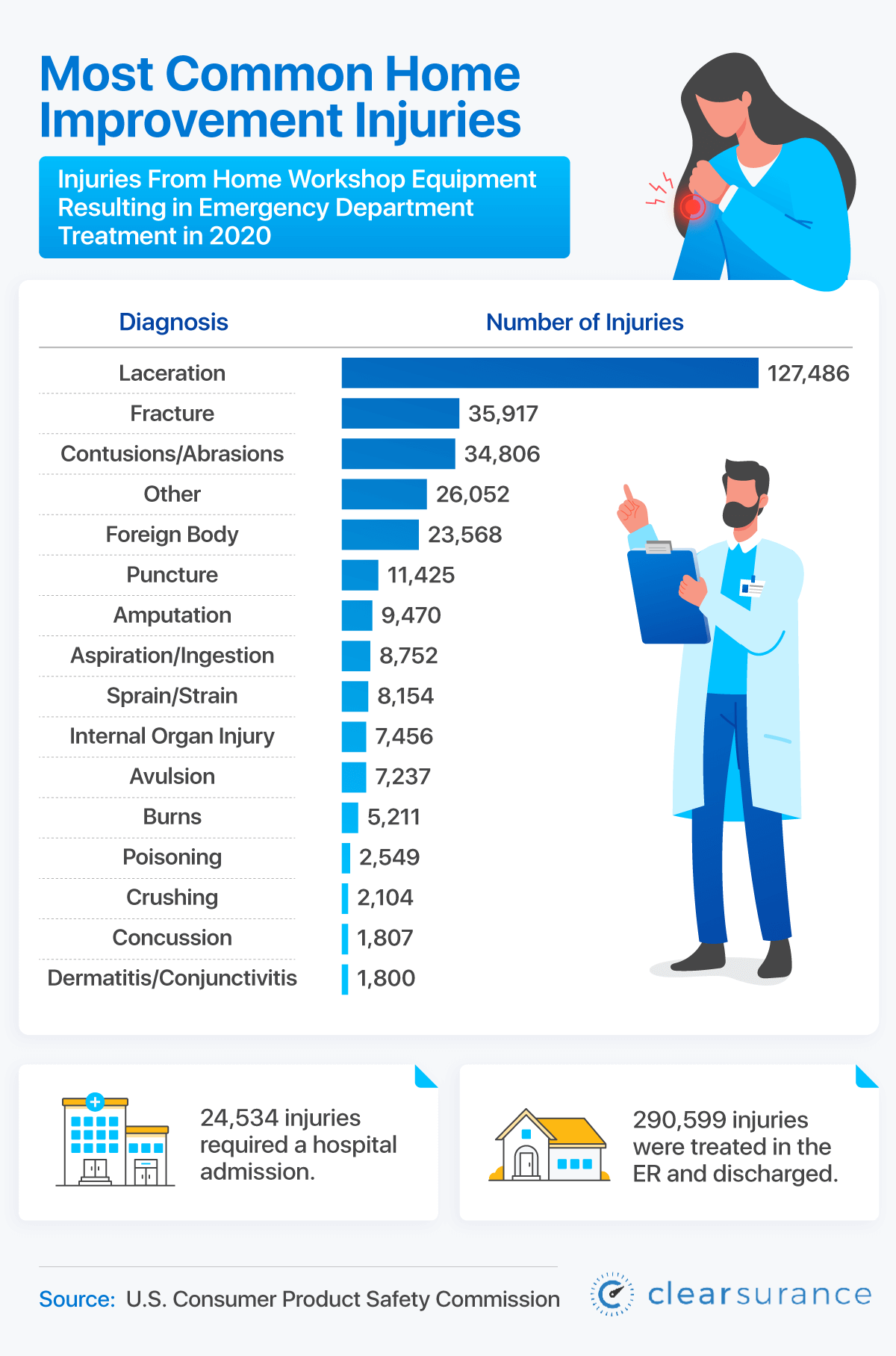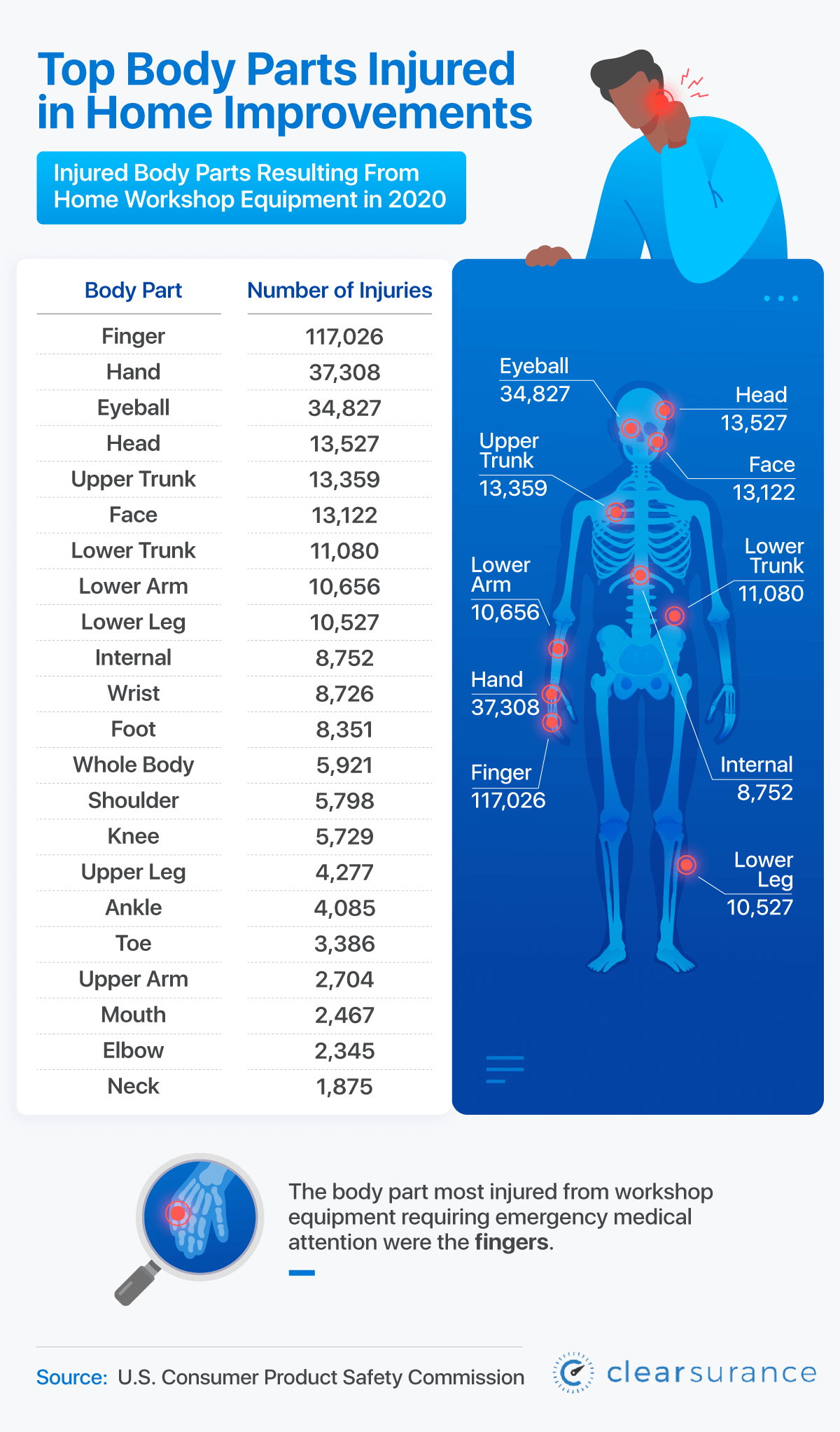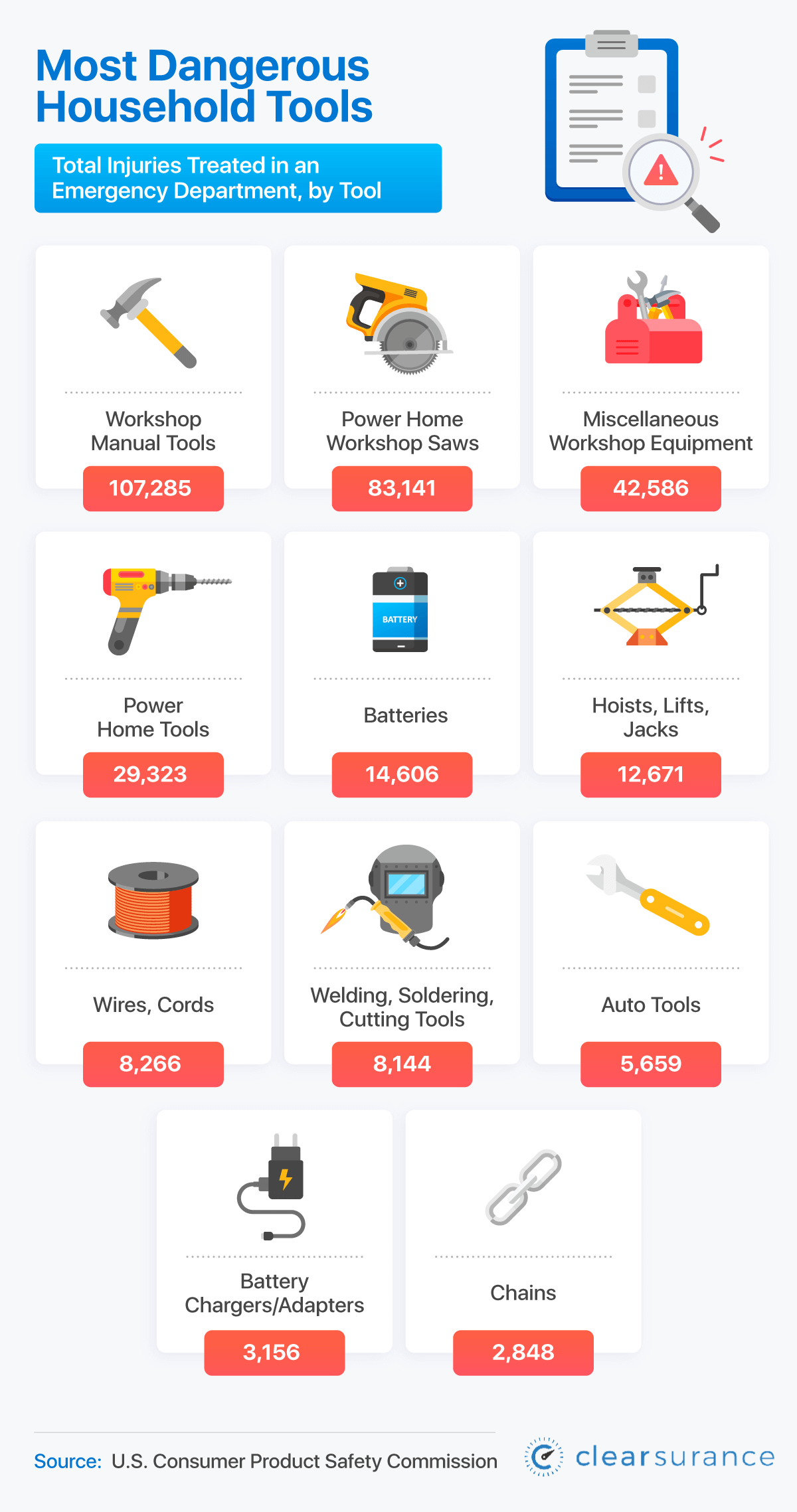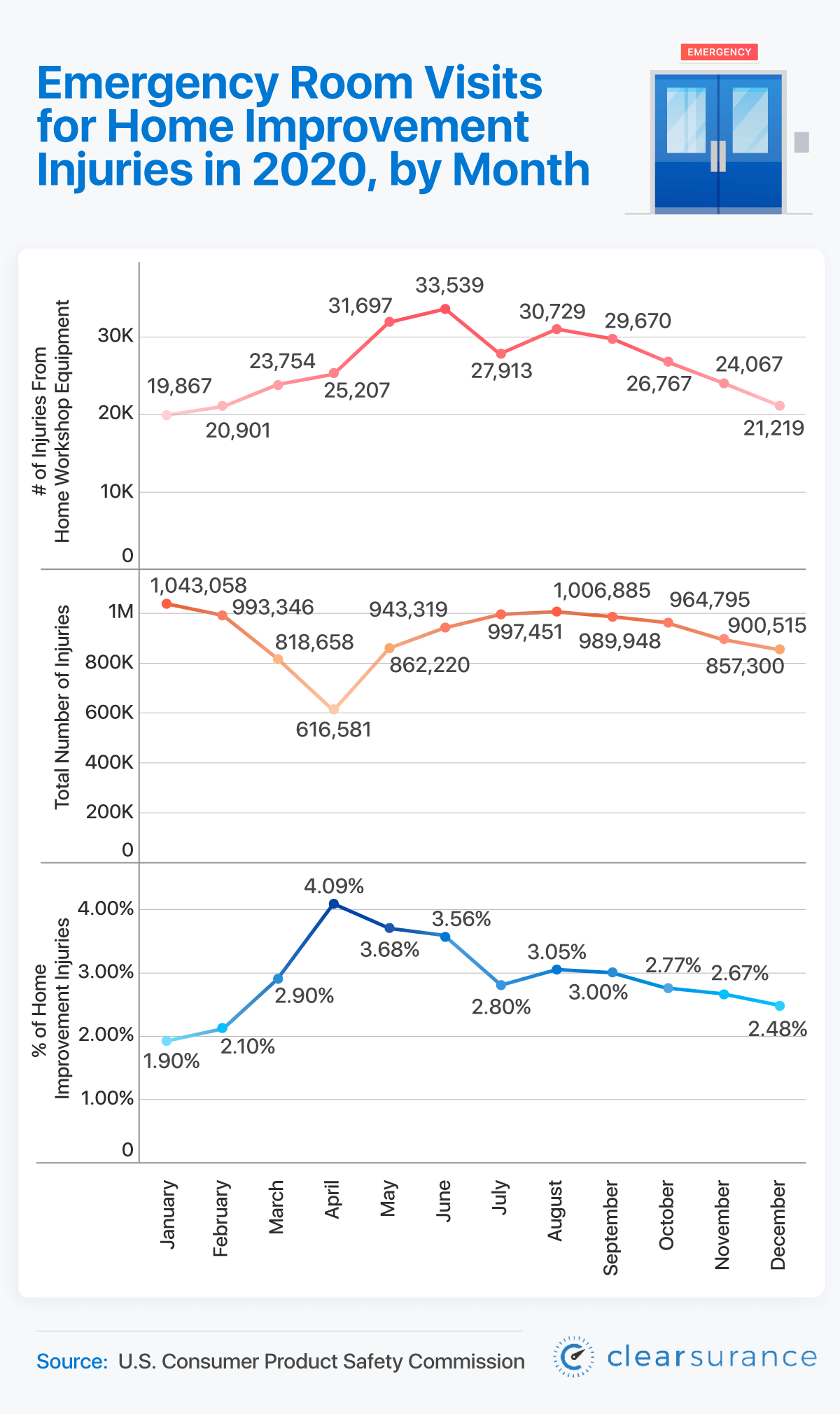
Things to Consider
- The most injured body part is the hand or fingers
- The neck was the least commonly injured body part, with only 1,875 injuries
- Home improvement injuries increase during the spring and summer
While DIY home improvement seems easier and cheaper than hiring a contractor, the reality is that any home project comes with bodily injury risks. No home improvement is entirely risk-free, whether it's dropping a can of paint on your toes or falling off a ladder.
What's the most common injury to happen at home? Lacerations to hands and fingers are the most likely injury to occur.
Homeowners looking to make renovations or repairs should have the best homeowners insurance in place if their DIY project goes wrong.
Keep reading to examine home improvement injury statistics and get expert advice and tips on home improvement safety.
Home Improvement Injury Statistics
Home improvement injuries are more common than one would think and result in thousands of emergency room visits every year.
Injuries can happen during all home improvement types. The most likely home improvement examples where people are hurt include simple renovations, like replacing kitchen cabinets or updating yards and landscaping.
In order to examine home accident statistics, our team of researchers collected data using the Consumer Product Safety Commission's (CPSC) National Electronic Injury Surveillance System (NEISS).
What are the most common injuries from home DIY projects? Below, you can see the household accident statistics for injuries caused by home improvement:

Lacerations were the most common injury from home improvement projects that led people to the ER.
There were 127,486 visits for lacerations, compared to 1,800 for dermatitis and conjunctivitis.
Other common home renovation injuries range in severity, from amputation to dermatitis. Around 25,000 of these injuries required hospital stays, whereas the rest were treated and then discharged from the ER.
Most Common Home Improvement Injuries
What are the most commonly injured body parts in home improvement projects? DIY accidents can injure a number of body parts from head to toe. The most injured part of the body is the finger.
Most home improvement projects deal with dangers to fingers. Whether hammering in a nail or using an electric saw, finger injuries (with hands coming in second for the most injuries) make sense as the most common injury.
So what is the most injured body part? Take a look at the graphic below to see the full range of DIY injuries.

The least commonly injured body part was the neck, with only a total of 1,875 injuries. The second-least-commonly injured body part was the elbow, followed by the mouth and upper arm.
To avoid common DIY accidents at home, make sure you know how to use tools properly before operating them. Additionally, make sure you're wearing the appropriate clothing so nothing gets stuck in the equipment while you're using it.
It's important to have good health insurance before you're injured during a home improvement project. While coverage may seem expensive, knowing how to find affordable health insurance can help cover expensive medical bills. Shop around and compare insurance quotes online to find coverage that fits your budget.
Most Dangerous Tools at Home
Your risk of being injured certainly depends partly on the type of tool being used. All home improvement projects come with risks, but you're less likely to be injured painting a wall than using a power saw.
What is the most dangerous tool to cause injury in home improvement accidents? The graphic below shows which tools are the biggest home improvement hazards:

You don't need to worry about the most dangerous power tools because manual workshop tools caused the most injuries, with 107,285 ER visits. These include any tool that doesn't require power, from screwdrivers to wrenches.
Chains caused the least amount of injuries, resulting in only 2,848 ER visits. Chainsaws, however, send 36,000 people to the ER every year according to the Center for Disease Control (CDC) chainsaw injury statistics.
When using any tool, it's important to study the manual and any training videos beforehand to avoid injuries. Leonard Ang, the CEO of iPropertyManagement.com, says, “YouTube is an incredible resource for home improvement projects. Great demonstration videos from amateurs and professionals will walk you through all the steps, highlight potential pitfalls, and point out specific safety concerns.”
Home Improvement Stores and Injuries
The U.S. Bureau of Labor Statistics manages home improvement store injuries as part of its annual Occupational Injuries and Illnesses report.
Car and transportation accidents are the top cause of workplace injuries, but nearly 40,000 people were sent to the ER with injuries resulting from contact with tools or equipment.
Not all of these incidents happened at home improvement stores, but it's important to note how national work injury trends can impact home improvement companies near you.
Home Injury Statistics Over Time
How have home improvement injuries changed over time? Are there more injuries in the summer or winter? For example, hurricane season impacts chainsaw accident statistics as more homeowners clean up fallen trees and debris on their property.
Let’s take a look at month-by-month data on ER visits associated with home improvement injuries.

The data you see above shows the percentage of injuries increased in the warmer spring and summer months, with the fewest percentage of injuries occurring in January.
Since COVID-19, many people have been tackling home improvement projects as they are spending more time at home. Has this resulted in an increase in ER visits? Take a look at the ER home improvements data below.

Interestingly, the number of home improvement injuries decreased from 2019 to 2020. This could be due to a number of reasons, from people avoiding ERs due to COVID-19 and the increase in virtual appointments.
However, the percentage of home improvement projects actually increased, making up a larger number of ER injuries, even if the overall numbers were lower.
Home Improvement Safety Tips and Insurance Advice
In order to prepare anyone looking to start a home improvement project, we've collected advice and home safety statistics from multiple experts.
Our home remodeling safety experts range from personal insurance lawyers to handymen and provider CEOs. They have tips on everything from finding affordable insurance and home improvement services to the safest at-home projects to do yourself.
The top five home improvement safety supplies to have on hand before you start any DIY project are:
- Safety glasses/goggles
- Face shield
- Gloves
- Protective headgear
- Ear plugs or protection
Wearing the proper clothes, including closed-toe shoes and long-sleeved shirts, will also protect you from many injuries caused by home improvement and tools.
Read on for expert advice and safety tips regarding the most common home improvement projects.

“As an insurance lawyer, I have to say that before you start any home improvement projects, you want to make sure that your insurance will cover you if you get injured.
There are a lot of insurance companies who will consider making your own home improvements as a kind of reckless endangerment, and you could possibly find yourself uncovered in the event of an emergency.
No one plans to get injured while doing a home improvement project, but it is better to be prepared for any scenario.
Therefore, if you have to pay a premium before you start just to make sure that you're going to be covered, that's definitely going to be your best option, no matter how safe you try to be. There are a wide variety of home improvement projects that you can take on that aren't dangerous, such as painting or building furniture.
Still, if you're going to start tearing down walls and climbing on roofs, you have to understand that your insurance company will have a limit. If you choose to do something dangerous and get hurt, your insurance company will find any reason not to pay for your injuries. If you get a good insurance lawyer, it's possible that they might be able to sort some deal for you.
Be aware of your policy and exactly what it states because your insurance company will have it written what they do and do not accept as accidents. A lot of the time, willful endangerment puts you over that limit.”

Anastasia Allmon is an attorney at FRPLegal.com.
Farris, Riley & Pitt, LLP is a group of personal injury attorneys.
Have you ever been injured doing home improvement?
"Yes, I have been injured while conducting home improvement projects. I was on the top rung of my ladder, trying to reach the corner of the wall to paint. Suddenly, the ladder gave way, and I fell on my back. For the next couple of minutes, there was only darkness."
Have you filed an insurance claim after a home improvement injury?
"Once I recovered, I filed an insurance claim. Luckily, I got sufficient coverage that allowed me to save enough money."
Have you hired an uninsured contractor to work in your home?
After my accident, I decided to stop DIY-ing and hired an uninsured contractor to finish the paint job I had started. Luckily, they suffered no injuries.
Would you recommend that people do their own home improvement if they have no experience?
"Speaking from my own experience, I wouldn't recommend homeowners to do their home improvement without any prior experience."
What can they do to prepare beforehand?
"They can prepare by watching YouTube tutorials of the particular task they are about to start. For instance, if their home improvement project involves cutting pieces of wood, they should watch a step-by-step guide to learn it before trying it out."
What are your top safety tips for people looking to do home improvement?
"Based on my previous experience, my number one tip would be to check your ladder for loose or broken joints. You will want to read the instruction manual before using any power tool and work in a room with good ventilation."
What are the most common home improvements that people try to do at home?
"The most common home DIY projects that people try at their home are interior and exterior painting, yard landscaping, and building things like bookshelves."
What home improvements are the most dangerous to complete for beginners?
"The most dangerous home improvements to complete at home for beginners are redoing your bathroom plumbing, fixing roof shingles, and replacing electrical panels.
Upgrading furniture with stencils, building trellis with planter boxes, and spray painting old picture frames are among the easiest home improvement projects for beginners to try."

William Connelly is the founder of Lottie.org.
Lottie helps families search for and compare senior care homes.
What are the risks of home improvement projects?
“There are many risks associated with home improvement projects, but some of the most common include:
Injuries – Home improvement projects can be dangerous if done improperly or without proper safety equipment. Workers may be reaching up high or working on unstable surfaces, which can lead to falls and other injuries.
Property damage – Home improvement projects can also cause damage to property if done incorrectly. Tools may fly off and hit people or objects in the house, causing injury or damage. Alternatively, improper installation of new materials may cause water leaks, roofing problems, or foundation issues that need to be fixed.
Financial losses – Home improvement projects can also lead to financial losses if mistakes are made. For example, if a contractor does not properly install materials or fails to complete tasks
There can be many risks involved with any home improvement project, just make sure to take all safety measures possible.”
How can you stay safe while DIYing?
“DIY projects can be a fun way to improve your home, but they can also be dangerous if done incorrectly. Follow these safety tips to stay safe while DIYing:
Get the right tools. Make sure you have the right tools for the job and use them safely. Use appropriate safety gear, including gloves, a face shield, and eye protection.
Watch your step. Be aware of your surroundings while working on your project, and take steps to avoid falls. Use a ladder cautiously if necessary, and use caution when walking on ladders or scaffolding.
Know Your Limit. Don't try to do too much at once or go beyond your skill level. Stick to simple tasks until you are more confident in your abilities.
Spending a few extra minutes planning your project can save you money in the long run.”

Lily Wili is the founder of Ever Wallpapers.
Her company sells wall murals and custom wallpapers.
“People often come to the experts for help with home improvements tasks after a previously poor experience with self-installation of their home security or other home projects - and a surprising number of those experiences have included an injury sustained during these instances.
A lot of people want to avoid hiring a contractor to install their home security system so that they can save money, so they will pull out their ladder and try to do it themselves. Unfortunately, whenever a ladder is involved, there is always a higher risk of injury due to a fall, especially when you don’t use a ladder or often do this installation.
I have talked to people that have broken a leg, foot, and even a hip because they fell off their ladder while installing a camera, and I have spoken with many homeowners who sustained bruises, cuts, and scrapes. I even once talked to someone who got scammed by a “contractor” she hired to install her cameras who fell while using her ladder.
While installing a home security system isn’t always a safety hazard, and the homeowner commonly does it, it can always be a good idea to have it professionally installed by the company (making sure that you verify the company and its credentials).
You may want to save money by doing it yourself, and you will probably avoid any delays in the process versus dealing with scheduling a professional. Still, I can guarantee that a hospital bill will cost you much more than paying a contractor to do it for it.”

Kristen Bolig is the CEO of SecurityNerd.com.
Her site provides detailed reviews on various security systems.
“Even before I started my business, I have been in the lawn care industry for years — dating back to when I was a teenager. I used to mow my neighbors’ lawns, remove their weeds, and occasionally operate some pretty dangerous machinery to help with building projects.
In my younger days, I never took any safety courses or paid attention to safety instructions, and unfortunately, I did end up with a couple of injuries.
The worst injury I sustained was from a chainsaw kicking back at me and hitting my arm while cutting through wood. I had to get stitches, but it could have been a lot worse, and I am thankful today that the cut didn’t go any deeper than it did.
That was a wake-up call injury for me and gave me enough of a scare to realize that I needed to pay much more attention to my safety when working.
Now that I own a business centered on lawn care servicing, I make an extra effort to ensure that all of my employees and people I hire for contracting are extensively trained on safety measures. My company also has a solid insurance policy in place in case of an employee or contractor gets injured.
Lawn care and home improvement projects are commonly completed by many homeowners, which means that many homeowners often operate machinery that can cause serious injury. I would encourage anyone using machinery or doing DIY home improvement to pay close attention to the safety hazards and best practices of their items.”

Jeremy Yamaguchi is the CEO of LawnLove.com.
His company provides lawn care listings and price quotes.
“Home improvement projects can be dangerous. Injuries can occur when attempting to install new accessories, appliances, or fixtures."
What are the risks of home improvement projects?
"Home improvement projects can be dangerous if not done correctly. There are many potential hazards, including falls, electrocutions, and slips and trips. Home improvement injuries can also occur from using the wrong tool or technique, working in poor conditions, or being injured on the job.
Injuries can result in long-term problems such as chronic pain and paralysis. If you are injured while working on your home improvement project, don't hesitate to seek medical attention.”
What can cause injuries during home improvement projects?
“Home improvement projects can be dangerous if done incorrectly. Improper use of power tools, poor workmanship, and lack of safety precautions can lead to serious injuries.
Common home improvement injuries include cuts from tools, falls from heights, getting hit by objects thrown during the project, and burns from hot liquids or chemicals. Injuries can also occur from contact with power lines or other dangerous equipment.
If you are injured in a home improvement project, consult an experienced attorney to learn your rights and options.”
How can you prevent injuries during home improvement projects?
“When undertaking a home improvement project, it is important to take precautions to avoid any injuries. Here are some tips to help you stay safe:
Always wear safety equipment, including gloves, safety goggles, and a dust mask if necessary.
Follow the manufacturer's instructions for your particular tool or appliance. If in doubt, ask a professional for help.
Use common sense when working in dangerous areas, such as high levels of electricity or sharp objects.
Stay focused on the task at hand and don't get sidetracked by distractions.
Home improvement projects can be dangerous. It is important to take precautions to prevent injuries. Always wear protective gear and follow the instructions of the professionals involved in the project.”

Davin Eberhardt is the founder of Nature of Home.
His company provides information about homes and gardens.
“There are a few different home improvement examples that you may want to consider when you are starting your project. This will help you better to estimate the costs and time requirements of your project."
What are some home improvement examples?
"Some examples of home improvement projects that you may want to consider are painting the exterior of your home, replacing the roof, updating the kitchen, and adding a loft area.”
What are the costs for these projects?
“The costs for these projects can vary depending on the size, complexity, and type of project that you are undertaking. However, some general costs that may apply to many of these projects are paint, roofing, kitchen upgrades, and loft additions.”
How long will it take to do these projects?
“The time required for most home improvement projects can vary greatly depending on the size and complexity of the project. However, generally speaking, expect to spend about one-third of the total project cost in the planning and preparation stage, one-third in the construction stage, and one-third in the finishing and cleanup stage.”
What are some common home improvement mistakes?
“There are a few common home improvement mistakes that you need to be aware of. Some of the most common mistakes include not budgeting enough money for the project, not preparing properly before starting the project, and making mistakes during the construction stage.
If you experience any type of injury while working on your home improvement project, don't hesitate to call 911 or go to the hospital.
Home improvement is a great way to improve your home and save money. By understanding some common home improvement examples, costs, and timelines, you can confidently start your project.”

Yan Margulis is the CEO of Capable Group Inc.
His home renovation company specializes in basement remodels.
“There are many people who are injured every year while doing home improvement projects. Many of these injuries are avoidable if you take the proper precautions. Here are some ways you can minimize the risk while tackling DIY projects at home.
- Wear safety goggles when using power tools. Even if you are only using the tool for a short time, particles can fly into your eyes and cause severe damage.
- Read instructions before using any tool. If the tool is made for a specific job, follow the directions. If it's not, use your common sense and don't perform any task you're not trained to do. Never use any power tool without reading the safety manual first.
- Wear safety shoes when doing any home improvement project. Even if you are walking around the floor, there is always a chance that something could slip and cause serious injury.
These actions may seem simple, but they will drastically minimize your chances of injuries.”
Have you ever been injured doing home improvement?
“Home improvement can often be dangerous, especially if you are not experienced. I have been injured a few times while doing home improvement projects. I tried to fix a pipe under the sink and cut my hand on the metal edge one time. Another time, I was using a power drill, and I accidentally hit my hand with the drill bit.”
Have you filed an insurance claim after a home improvement injury?
“In some cases, filing a claim may result in coverage for the damages incurred; in others, it may not. Some factors that often influence the decision include the type of policy purchased, the specific incident that occurred, and whether or not the policyholder was at fault.”
Have you hired an uninsured contractor to work in your home?
“No way. Generally speaking, though, hiring an uninsured contractor can be risky. You may be left responsible for any damages or injuries that occur as a result of the work.”
Would you recommend that people do their own home improvement if they have no experience?
“There is no right or wrong answer to this question. It depends on the specific project and the person's level of experience. People without any experience should probably not attempt a home improvement project independently.
Several risks are involved, including safety hazards, and it is often difficult to correctly assess and execute the necessary tasks. Hiring a professional contractor is frequently more expensive, but you may save money in the long run by avoiding injuries.”
What are your top safety tips for people looking to do home improvement?
“Many safety tips can be shared when it comes to home improvement. One of the most important is always being aware of your surroundings and what you are doing. Make sure to use caution when using any tool or working with any kind of material that may be dangerous.
Make it a priority always to read labels and follow directions. Be sure to have plenty of space to work in and keep bystanders away.”
What are the most common home improvements that people try to do at home?
“People attempt many home improvements, but some of the most common are painting, fixing the roof, and remodeling the kitchen or bathroom. Often these projects are undertaken to increase the home's value or make it more comfortable for living. However, they can often be difficult and time-consuming, so it is crucial to plan and budget for them carefully.”
What home improvements are the most dangerous to complete for beginners?
“Home improvement projects can be dangerous for beginners if they are not correctly educated on how to complete the project. Projects such as wiring and plumbing can be hazardous if not done correctly. Improperly installed wiring can lead to electrical fires, and improperly installed plumbing can lead to water damage in the home.”
What home improvements are the easiest?
“One easy way to improve your home is by adding insulation. Insulation helps keep your home warm in the winter and cool in the summer. Adding insulation is a relatively easy and safe project.
Another easy project is to paint your walls. Painting can brighten up a room and make it feel new. It is also a relatively easy project that can be done over a weekend.”

Ben Green is a founder of GreenLeafAir.com.
Green Leaf Air is a handyman and HVAC service provider.
Have you ever been injured doing home improvement?
“I injured myself clearing the gutters at my parent's house. They had an old wooden ladder which I think has been around since I was a kid. One of the rungs snapped while I was on my way down the ladder, and I fell and sprained and bruised my ankle.”
What can they do to prepare beforehand? What are your top safety tips for people looking to do home improvement?
“My ladder fall could have easily been prevented by a quick check of all my tools before starting the job, so I'd recommend doing basic checks of all your tools before starting. You should also quickly assess the area and clear any trip hazards or other potentially dangerous items.
It's also a good idea to watch a few YouTube videos and make sure you are honest with yourself about your abilities.
Ask yourself what you are risking if you fail to complete the job correctly. Will you lose a few hours of your time and perhaps waste some materials? Or are serious injuries a possibility? Consider asking an experienced friend to help or hiring an insured contractor if it's the latter.”
Would you recommend that people do their own home improvement if they have no experience?
“As long as there is no chance of an injury, and people are comfortable with any lost time or money that may be incurred if something goes wrong - I'd say go for it!”
What home improvements are the easiest?
“Installing a water filter is an achievable home improvement for most people. If you've used a drill, a screwdriver, and a hammer before, you should already have most of the skills needed.
These days most manufacturers provide YouTube videos and customer support by telephone. The biggest problem you're likely to face is having valves and pipe connections that are not compatible which can be easily solved with a drive to the local hardware store to pick up the correct adapter.”

Paul Lewin is the founder of HomeWaterResearch.com.
His company provides information on home water filters and testing.
What are the risks of home improvement?
“Home improvement projects can be dangerous. Injuries are common when improper precautions are not taken.
Home improvement projects can be dangerous if done incorrectly. Home improvement injuries can include cuts, falls, burns, and electrocutions.
The most common home improvement injuries are cuts and falls. Cuts from power tools, knives, saws, and other equipment can lead to serious injury. Falls from ladders or scaffolding can also lead to serious injury or death.
Home improvement fires are also a danger. Electrical fires caused by improper wiring or faulty equipment are a common cause of home fires. Burn injuries from hot liquids or solvents used in home improvement projects can be very serious and require extensive treatment.”
What should you do to protect yourself?
“When considering home improvement projects, it is important to take safety precautions to avoid any potential injuries.
To protect yourself when working on your home:
- Always use safety equipment, such as kneepads or a hardhat.
- Stay well lit and wear bright colors so you can be easily seen.
- Use caution when working near high voltage wires or power lines; always stay away from them until you are sure they are safe to cross.
- Use common sense when working in unfamiliar surroundings; if in doubt about the safety of an area, ask someone for help before proceeding.
Home improvement injuries can occur from a variety of sources, including falls, slips and trips, equipment failure, and contact with sharp objects.”
What should you do if you are injured?
“If you are injured in a home improvement accident, you should seek professional medical help. Home improvement injuries can be serious and may require hospitalization.
If you are injured in a fall, for example, you may suffer broken bones or other injuries that will need medical attention. You should also report the accident to the police if it occurred at someone else's home and they were not present at the time of the accident.
Home improvement projects can be dangerous. Take proper precautions to protect yourself and your loved ones. If you are injured, seek medical help.”

Melanie Cohen is the co-founder of Instya.com.
Their company provides comparison lists for home improvement products.
What are the most common home improvement injuries?
“Home improvement projects can be fun, but they can also be dangerous. If you are not careful, you can injure yourself while installing a new door or windows.
There are a lot of different ways that people can get injured while doing home improvement projects, from slipping and falling to getting hit by something falling off the wall.
One of the most common types of home improvement injuries is from using tools incorrectly. For example, if you're trying to do a job with a power drill and you're not used to using one, it can be easy to accidentally force too much power into the drill bit and cause serious injury.
Another common hazard is working around water pipes or electrical cables. If you're not careful, these things can give you an electric shock or knock you into water that's going to turn your wet clothes into mush.
If you're ever in doubt about whether or not something is safe to do on your own property, it's always best to ask a professional. They'll be able to tell you what hazards are likely to present in the area and help make sure that everything goes safely and without incident.”
How can you avoid injury?
“There are many ways to avoid injury when working on home improvement projects. Follow the safety guidelines that your project requires, use common sense, and take precautions when working in high–risk areas.
Firstly, always wear proper safety gear, including a helmet, gloves, and eye protection. When possible, work in controlled environments with adequate lighting and ample access to emergency exits. Whenever possible, use approved materials and equipment that have been specifically designed for home improvement projects.
Secondly, always use proper tools and equipment. Make sure that the tools you are using are sharpened correctly and the blades are properly aligned. Use the correct size tool for the job at hand. Avoid using tools that are too heavy or too small for the task at hand.
When working with power tools, use caution when cutting or drilling because they can be dangerous if not used properly. Finally, work in a controlled manner so that you do not injure yourself or others while completing your home improvement project.
Home improvement projects can be dangerous, but if you follow the proper precautions, you can avoid serious injury. If you do suffer an injury, be sure to seek medical attention.”

Ryan Brown is the founder of Art of Lock Picking.
His site provides insight on home features that increase safety.
What can go wrong with home improvement projects?
“Home improvement projects can be dangerous. Injuries can happen if you are not careful. Many things can go wrong when homeowners try to improve their homes, whether fixing a water leak, installing new flooring, or adding a porch.
Common problems involve misusing tools, falls from high places, and faulty installations. Homeowners should take precautions before starting any home improvement project, including checking the manufacturer's instructions carefully and consulting with a professional if they have any doubts about how to do something safely.”
How to Keep Yourself Safe While Home Improving
“When doing home improvement projects, it's essential to take safety precautions to avoid injury. Here are a few tips to keep yourself safe while working in your home:
- Wear proper attire. Wear clothes that protect you from dirt, dust, and debris while working in your home. You might also want to consider wearing a face mask if you're working with chemicals or other potentially dangerous materials.
- Use the right tools for the job. Make sure that the tools you use are appropriate for the task at hand and safely handle them correctly. For example, a saw should only be used with proper safety precautions (e.g., wearing protective gear) and never close to your body when operating it.
- Follow all safety guidelines closely. Always follow all safety guidelines closely when working in your home, even if they seem obvious or familiar sense-based (e.g., use caution when stepping on ladders). If something seems wrong or dangerous, don't do it! Contact a professional for help before any harm occurs
Home improvement projects can be dangerous. If you are careful, you can avoid injuries. If you do happen to injure yourself, be sure to take proper precautions.”

Brett Arrington is the owner of WeBuyGreensboroAreaHouses.com.
His company provides real estate help for the fast-paced housing market.
What types of home improvement injuries are there?
“There are a variety of home improvement injuries that you may experience, ranging from simple sprains and strains to falls and even car accidents.”
How common are home improvement injuries?
“Home improvement injuries are not uncommon, and they can happen to anyone. They are the most common type of injury that workers experience.”
How can I avoid home improvement injuries?
“There is no guaranteed way to avoid home improvement injuries, but following some simple safety tips can help decrease your chances of serious injury. Use the proper tools and equipment to stay safe while working on your home.
Be sure to know your skill level; if heavy equipment is needed and this is your first time using it, it may be better to hire a professional. Always be aware of your surroundings, body, and how everything is moving around.
If you have ever been injured while making home improvements, you know that the pain and suffering can be overwhelming. As stated above, home improvement injuries can range from simple sprains and strains to more severe injuries, such as falls and car accidents.
Home improvement injuries are not uncommon, and they can happen to anyone. They are the most common type of injury that workers experience. The main symptoms of a home improvement injury can vary. They usually include pain at the area of injury, redness, swelling, tingling, and the inability to move the injured area.”
Have you filed an insurance claim after a home improvement injury?
“No, I haven't. Home improvement cases can vary depending on the type of accident and the cause of the injury that occurred. While every case is different, it is important to speak with your insurance company to see if you are covered.”

Gary Parker is the CEO of GaryBuysHouses.com.
His company provides real estate help for the fast-paced housing market.
Dangers of Home Improvement
"Home improvement projects can be dangerous. Injuries can happen when things go wrong. Many dangers are associated with various types of home improvement projects, both DIY and professional. It is essential to be aware of these potential hazards to avoid injury.
Some of the most common hazards include trips and falls, electric shock, burns, and injuries from tools or equipment. When undertaking any home improvement project, it is essential to use proper safety gear (such as gloves, goggles, and a dust mask) and follow all instructions carefully.
If you do get injured while working on your home, don't hesitate to seek medical attention."
What should you do if you are injured?
"If you are injured during a home improvement project, there are a few things you should do. First, take stock of the situation and determine whether you are injured in the course of an accident or if there is something wrong with the project itself.
If it is an accident, assess any injuries and seek medical attention as soon as possible. If something is wrong with the project, find out what caused the damage and take appropriate action to prevent it from happening again."
How to Avoid Injuries During Home Improvement Projects
"There are a few simple ways to avoid getting injured while working on home improvement projects. First, always wear appropriate safety gear, including gloves, safety goggles, and a dust mask. If you are using a power tool, make sure you use the correct safety precautions and stay well clear of the blade.
And lastly, be aware of potential hazards around your work area and keep an eye out for falling objects. Following these simple tips can avoid any injuries during your home improvement projects."

Peter Beeda is the COO of FHALend.com.
The company provides equal-opportunity home loans.
"Home improvement injuries are more common than many people tend to think. When people think of injuries that happen at home, they think of common injuries like accidentally hitting your finger with a hammer. Still, other more severe injuries can occur when homeowners attempt improvement projects instead of hiring professionals.
Two of the more severe injuries from homeowner's DIY-ing projects are Electric shock and falls from ladders.
Electric shocks can range from a mild, acute jolt to a powerful surge that stops your heart. Electric shocks are prevalent during house renovations, and they mainly happen when circuit breakers and wiring are replaced without the power being switched off.
As previously noted, electrocution can also occur when working with electricity while standing on a metal ladder or when using malfunctioning power tools. When it comes to tackling electrical projects at home, it can be costly to hire a professionally licensed electrician. Still, an injury to yourself or even death will cost substantially more in the long run.
Most home repair projects require a ladder, and it might come as no surprise that ladders are a significant cause of fatalities. Homeowners who use ladders on a more consistent basis may quickly forget about the safety precautions they should take while using a ladder.
Fractures of the arms, hands, ankles, neck, and legs and possibly severe traumatic brain injury are the most common injuries caused by a ladder fall (TBI). Furthermore, utilizing a metal ladder to install or repair electrical equipment can put you at risk of electrocution and falling from a great height."

Robin Antill is a senior partner of LeisureBuildings.com.
1st Choice Leisure Buildings is an internet retailer of garden buildings.
“Home improvement can be dangerous if not done right. That is why it is essential to make sure that when you hire a contractor to improve your home, you know if they are covered under worker's compensation.
If you have hired a contractor from a larger company, ask if the company has a workers' compensation policy. If the person you hired to do your home improvements is self-employed or an independent contractor, there is a chance these contractors may not have workers' compensation coverage.
In this case, you should check with the provider of your homeowner's insurance to see if that will cover the worker in the event they suffer an injury. In most cases, homeowners' insurance will cover you in the event of a situation like this, provided you as the homeowner are not found negligent.
For example, you would most likely not be covered by homeowners insurance if a contractor you hired to fix your upstairs bathroom injured themself going upstairs.
If you, as the homeowner, were aware, the stairs they used to access the upper floor were in disrepair and could cause injury. Still, you took no steps to warn the contractor or repair the stairs; your insurance may find you liable for damages and not cover the situation.
In the worst-case scenario, if a contractor was injured and you were found to be negligent as the property owner, you risk the potential of getting sued by the injured worker and have to pay out of pocket.”

Sean Malloy is a managing partner at Malloy-Law.com.
Malloy Law Offices is a personal injury law firm.
Methodology: Researching Home Improvement Injury Statistics
In order to determine what home improvement injuries are the most prevalent, our team of researchers collected data from the NEISS. Using the query function, our researchers pulled data on injuries from home workshop equipment.
Multiple queries were conducted that looked at injury types, injury locations, gender, multiple dates, disposition, and age groups. To determine what percentage of injuries were from home workshop equipment in 2020, our researchers pulled the total number of injuries in 2020. Then, the number of injuries from home workshop equipment was then divided by the total number of injuries in 2020.
Pulling this data allowed our researchers to examine multiple patterns over time, from the most common tool that caused injuries to the number of injuries over time.
No matter what home repair job you are doing, use caution and make sure to pay a visit to the doctor if you are injured.
References:
Frequently Asked Questions
What are DIY injuries?
DIY injuries occur when someone is injured while doing home renovations or improvements themselves.
What home improvement injury causes the most emergency room visits?
Lacerations and deep cuts requiring stitches are the most common home improvement injuries.
Where do most injuries occur in the home?
Most home injuries occur in the bathroom or near or around the shower.
What are the common accidents at home?
The most common accidents at home are slips and falls and accidental poisonings. The most common home improvement accidents are cuts.







